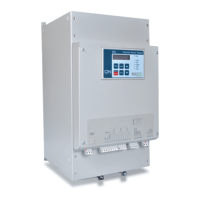10 • Technical Data
________________________________________________________________________________________________
Note:
Tct = 1-10Sec.
(Adjustable in 0.1 sec
steps)
Ton=2 cycles – Tct
Seconds (Minimum
conducting time is 2
cycles)
3.8.2 Phase Control
In this mode of operation thyristor’s firing is performed in every half cycle proportional to the analogue input.
Maximum analogue input will cause a full wave to load. When analogue input is lower, a proportional part of
the sine wave will be delivered to the load.
Main advantages of this mode are:
Enables “Soft start”
Current variations are limited.
Main disadvantages are:
Relatively high RFI noise.
Relatively high current THD.
Note:
When load is connected in WYE NEUTRAL NOT CONNECTED or in LINE DELTA (both connections are
without a neutral point) AND TPS is in PHASE CONTROL it is impossible to go to zero output.
Minimum possible firing for such case gives 10-20% of output voltage. This is since in this case the firing of
each phase depends on the three phases mains and we cannot control each phase voltage down to zero.
In this case, zero input in analogue input causes the minimum possible voltage to appear in the output. Then,
upon increasing the analogue input voltage, output voltage/current is monotonically increased.
Firing method must be programmed to TPS. Refer to section
7.7.1 page 28.
3.8.3 Phase control to zero crossing (Soft start)
The user can program a time of which the TPS will function in PHASE CONTROL and then change to ZERO
CROSSING mode.
This mode of operation allows soft starting of the load. This mode is recommended when load resistance has
a temperature dependant characteristic (lower resistance when cold).
Program PHASE CONTROL TO ZERO CROSSING time to a value from 1-3600 seconds.
During starting the TPS for the first 1-3600 seconds , TPS will operate in PHASE CONTROL mode of
operation thyristor’s firing is performed in every half cycle proportional to the analogue input.
The outcome of this process will be a small current withdraw from the supply and slow heating of the heat
element thus increasing its resistance and lowering the current.
Firing method must be programmed to TPS. Refer to section
7.7.1 page 28.
3.8.4 Phase Control-Power
In this mode of operation TPS function in PHASE CONTROL (See explanations above).
In PHASE CONTROL-POWER the output power of the TPS will be kept linear to the analogue input of the
TPS.
Firing method must be programmed to TPS. Refer to section
7.7.1 page 28.

